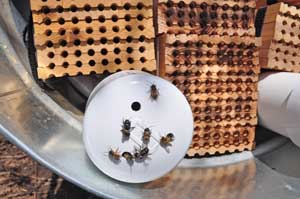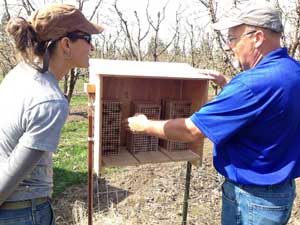
Dormant mason bees are delivered to the grower in a plastic tube with the hole taped closed. As soon as conditions warm up and the tape is removed, the bees will emerge. Courtesy of Crown Bees
Mason bees have the potential to help tree fruit growers in the Pacific Northwest to significantly improve yields, according to four bee suppliers who say these solitary bees can be more effective pollinators than honey bees.
The four collaborating suppliers have bred half a million mason bees to supply to orchardists for pollinating next spring. They are: Mason Bees for Sale in Roy, Utah; Crown Bees in Woodinville, Washington; Watts Solitary Bees in Bothell, Washington; and Bella Vista Farms in Eagle, Idaho.
Clint Merrill, vice president of sales with Mason Bees For Sale, said only a few hundred mason bees are needed to pollinate an acre of orchard. In comparison, one honeybee hive contains 20,000 to 30,000 bees.
The mason bee is a superior pollinator because it’s not efficient at keeping the pollen that it’s collected on its body, so as it jumps from flower to flower some of the pollen comes off, he said. Also, mason bees, which live for only a few weeks, will work the orchard when it’s windy, rainy, or cool.
Each female mason bee is a queen that goes out and collects nectar and pollen. She makes nests and lays eggs in reeds or natural holes. Growers can provide bee houses made of wood with holes drilled into them to serve as nesting sites.
Merrill said the mason bee needs three things to be successful: mud, a nest, and pollen. If all of those are provided, the bee will stay in the immediate area, but if any one is missing, the bee will travel up to half a mile to find a more suitable place. Bees use the mud to partition the cells of the nest. Clay mud works best. Bee houses should be located close to the mud source.
“If you don’t have mud, you’re toast,” said Dave Hunter, owner of Crown Bees, who recommends leaving water dripping in the orchard to create mud or bringing a bucketful in. Only a small amount is needed per acre.

Jen Kroner, owner of Big Barn Organics, and Jim Watts, owner of Watts Solitary Bees, check on mason bee houses at Kris Fade’s orchard in Hood River, Oregon. Courtesy of Crown Bees
The suppliers recommend that growers start out with 500 dormant bees per acre. They are delivered in late winter in a tube sealed with duct tape, along with four wooden bee houses per acre. The houses should be tied to tree limbs at a height of about four feet facing southeast so they receive good morning sunlight.
The bees can be kept in a cooler until a couple of days before the orchard is in bloom. They should then be kept at room temperature for a short time to warm up before being released in the orchard. The bees mate soon after being released. Males only live for two weeks.
During pesticide applications, shower caps can be placed over the houses to protect the bees. For the bees to survive to the next generation, the houses need to be left in the orchard for six weeks and not moved within the orchard, otherwise some of the bees will be unable to find them.
Jim Watts, with Watts Solitary Bees, said that after the six-week period, the houses can be taken out of the orchard and stored in a shed. The bees go through only one generation per year. By fall, they develop into cocooned larvae ready to overwinter. During the winter, the houses can be opened up and cleaned, ready to be put out again the following spring.
The four bee suppliers have enough bees to supply 500 acres in the coming season and have been presenting workshops for growers to explain the benefits of using mason bees. The bees can be either purchased or leased. For more information contact: www.masonbeesforsale.com; www.wattsbees.com; crownbees.com; or www.bellavistafarms.com.
The handbook “How to Manage the Blue Orchard Bee As an Orchard Pollinator” by Jordi Bosch and William Kemp published by The U.S. Department of Agriculture provides in-depth information on mason bees. Copies are available from www.amazon.com.






Leave A Comment